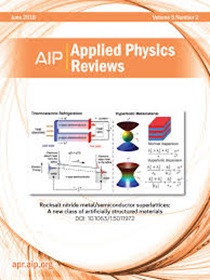零附近的非线性光学:从原点到新材料
IF 11.6
1区 物理与天体物理
Q1 PHYSICS, APPLIED
引用次数: 0
摘要
在不断发展的非线性光学领域,epsilon近零(ENZ)材料已经引起了重大的科学兴趣,成为过去十年中引人注目的焦点。在此期间,研究人员展示了非线性过程的非凡演示,例如通过强度相关折射率的单位阶折射率变化,增强的二次谐波产生,超薄膜中的饱和吸收以及最近通过介电常数的时间调制进行的频移。最近,在揭示ENZ材料的非线性光学行为的复杂性方面也取得了显著的进展。这篇综述提供了在这些系统中常见的各种非线性类型的全面概述,重点是基于德鲁德的均质材料。通过将增强分为内在因素和外在因素,为ENZ介质的非线性与其他非线性介质的非线性比较提供了一个框架。该评论强调,尽管ENZ材料可能不会显著超越传统材料的非线性能力,无论是在快速还是慢速非线性方面,但它们确实具有明显的优势。这些优点包括最佳响应时间、固有的慢光效应增强和宽带特性,所有这些都封装在可以购买的现成薄膜中。该综述进一步建立在这个框架的基础上,不仅确定了透明导电氧化物的关键特性,这些特性迄今为止使它们成为ENZ非线性的理想测试平台,而且还带来了可能优于它们的替代材料系统,如钙钛矿氧化物。最后,我们回顾了即将到来的时变物理概念,并概述了研究界正在努力的关键点。本文章由计算机程序翻译,如有差异,请以英文原文为准。
Nonlinear optics at epsilon near zero: From origins to new materials
In the continuously evolving realm of nonlinear optics, epsilon near zero (ENZ) materials have captured significant scientific interest, becoming a compelling focal point over the past decade. During this time, researchers have shown extraordinary demonstrations of nonlinear processes such as unity order index change via intensity dependent refractive index, enhanced second harmonic generation, saturable absorption in ultra-thin films and more recently, frequency shifting via time modulation of permittivity. More recently, remarkable strides have also been made in uncovering the intricacies of ENZ materials' nonlinear optical behavior. This review provides a comprehensive overview of the various types of nonlinearities commonly observed in these systems, with a focus on Drude based homogenous materials. By categorizing the enhancement into intrinsic and extrinsic factors, it provides a framework to compare the nonlinearity of ENZ media with other nonlinear media. The review emphasizes that while ENZ materials may not significantly surpass the nonlinear capabilities of traditional materials, either in terms of fast or slow nonlinearity, they do offer distinct advantages. These advantages encompass an optimal response time, inherent enhancement of slow light effects, and a broadband characteristic, all encapsulated in a thin film that can be purchased off-the shelf. The review further builds upon this framework and not only identifies key properties of transparent conducting oxides that have so far made them ideal test beds for ENZ nonlinearities, but also brings to light alternate material systems, such as perovskite oxides, that could potentially outperform them. We conclude by reviewing the upcoming concepts of time varying physics with ENZ media and outline key points the research community is working toward.
求助全文
通过发布文献求助,成功后即可免费获取论文全文。
去求助
来源期刊

Applied physics reviews
PHYSICS, APPLIED-
CiteScore
22.50
自引率
2.00%
发文量
113
审稿时长
2 months
期刊介绍:
Applied Physics Reviews (APR) is a journal featuring articles on critical topics in experimental or theoretical research in applied physics and applications of physics to other scientific and engineering branches. The publication includes two main types of articles:
Original Research: These articles report on high-quality, novel research studies that are of significant interest to the applied physics community.
Reviews: Review articles in APR can either be authoritative and comprehensive assessments of established areas of applied physics or short, timely reviews of recent advances in established fields or emerging areas of applied physics.
 求助内容:
求助内容: 应助结果提醒方式:
应助结果提醒方式:


